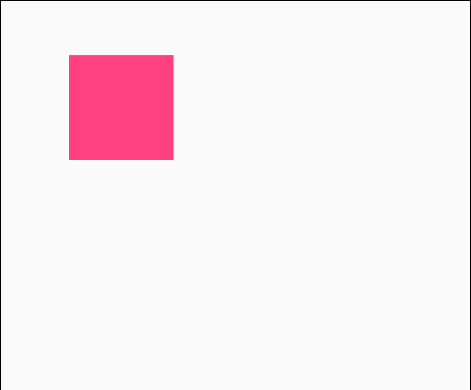實現一個隨著手指滑動的View
阿新 • • 發佈:2019-02-01
1、android View 主要6種滑動方法,分別是
- layout()
- offsetLeftAndRight()和offsetTopAndBottom()
- LayoutParams
- scrollBy()和 scrollTo()
- Scroller
- 動畫
2、實現效果圖
3、自定義中使用layout()方法實習view的滑動
2、offsetLeftAndRight()和offsetTopAndBottom()public class MoveView extends View { private int lastX, lastY; public MoveView(Context context, @Nullable AttributeSet attrs) { super(context, attrs); } public MoveView(Context context, @Nullable AttributeSet attrs, int defStyleAttr) { super(context, attrs, defStyleAttr); } public MoveView(Context context) { super(context); } public boolean onTouchEvent(MotionEvent event) { int x = (int) event.getX(); int y = (int) event.getY(); switch (event.getAction()) { case MotionEvent.ACTION_DOWN: lastX = x; lastY = y; break; case MotionEvent.ACTION_MOVE: int offsetX = x - lastX;//計算滑動的距離 int offsetY = y - lastY; //重新放置新的位置 layout(getLeft() + offsetX, getTop() + offsetY, getRight() + offsetX, getBottom() + offsetY); } return true; } }
3、LayoutParams 改變佈局引數的方法:public boolean onTouchEvent(MotionEvent event) { int x = (int) event.getX(); int y = (int) event.getY(); switch (event.getAction()) { case MotionEvent.ACTION_DOWN: lastX = x; lastY = y; break; case MotionEvent.ACTION_MOVE: int offsetX = x - lastX;//計算滑動的距離 int offsetY = y - lastY; //重新放置新的位置 // layout(getLeft() + offsetX, getTop() + offsetY, getRight() + offsetX, getBottom() + offsetY); offsetLeftAndRight(offsetX); offsetTopAndBottom(offsetY); } return true; }
4、當然使用動畫 ,scrollBy()和 scrollTo()也可以使view滑動,不足的是使用scrollBy()和 scrollTo()滑動時,是瞬間完成的,使用者體驗不太好。public boolean onTouchEvent(MotionEvent event) { int x = (int) event.getX(); int y = (int) event.getY(); switch (event.getAction()) { case MotionEvent.ACTION_DOWN: lastX = x; lastY = y; break; case MotionEvent.ACTION_MOVE: int offsetX = x - lastX;//計算滑動的距離 int offsetY = y - lastY; //重新放置新的位置 // layout(getLeft() + offsetX, getTop() + offsetY, getRight() + offsetX, getBottom() + offsetY); // offsetLeftAndRight(offsetX); // offsetTopAndBottom(offsetY); LinearLayout.LayoutParams layoutParams = (LinearLayout.LayoutParams) getLayoutParams(); layoutParams.leftMargin = getLeft()+offsetX; layoutParams.topMargin = getTop() +offsetY; setLayoutParams(layoutParams); } return true; }
5、Scroller和 View的computeScroll() 結合使用,實現view平滑的移動
public class MoveView extends View {
private Scroller mScroller;
public MoveView(Context context, @Nullable AttributeSet attrs) {
super(context, attrs);
mScroller = new Scroller(context);
}
public MoveView(Context context, @Nullable AttributeSet attrs, int defStyleAttr) {
super(context, attrs, defStyleAttr);
}
public MoveView(Context context) {
super(context);
}
//重寫computeScroll方法
@Override
public void computeScroll() { //view在onDraw的時候會呼叫此方法
super.computeScroll();
if (mScroller.computeScrollOffset()) {
((View) getParent()).scrollTo(mScroller.getCurrX(), mScroller.getCurrY());
invalidate();
}
}
//在外部呼叫這個方法即可
public void smoothScrollTo(int destX, int destY) {
int scrollX = getScrollX();
int delta = destX - scrollX;
mScroller.startScroll(scrollX, 0, delta,0 ,6000);
invalidate();
}
}
